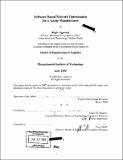Software based network optimization for a large manufacturer
Author(s)
Agarwal, Rajiv, 1969-
DownloadFull printable version (6.829Mb)
Other Contributors
Massachusetts Institute of Technology. Engineering Systems Division.
Advisor
James M. Masters.
Terms of use
Metadata
Show full item recordAbstract
With expansion of commerce and boundaries of business, organizations have been working hard at improving processes and bills of material and have reached the bottom already. The focus is therefore, now shifting to the next logical area of optimization of supply chains. The ever-increasing competition is putting pressure on organizations to optimize their supply chains and many organizations are reevaluating their existing supply chain networks. Often, as expected, they realize that it requires a complete overhauling. There may be too many suppliers or too many distribution centers, not quite optimally aligned in the chain. The important issue is not to impact customer service adversely, and yet, make the desired changes in the network. A member company from the Affiliates Program at MIT's Center for Transportation Studies is one such company, looking at re-configuring their distribution system, questioning the need for multiple echelons in their distribution system. They are looking at reducing the number of Delivery Center locations and the possibility of doing away with the Central Distribution Centers where shipments from the plants are consolidated for shipment to the DCs. This study aims to address the following related issues: What is the impact of reducing the number of DCs? What would be the optimal location of a third DC assuming 2 DCs are known? What would be the customer allocations in the new network with 3 DCs? How would the assignments change if there was a capacity constraint posed on the DCs? These issues were approached as a facility location problem with an objective function to meet the customer demand at the minimum cost. In a typical system, the constituents of this cost would be the transportation cost - Plant to DC to Customer, facility operating cost and the cost of carrying inventory at each DC. The number, location and size of the DCs relative to the plants and customer zones would be some of the decision variables that influence these costs. The study was conducted by structuring the company data from the previous year into a model and using a mixed integer linear programming tool to arrive at the optimal solution. SAILS - ODS, a supply chain network optimization software, was used as the solver for the network model. For the purpose of this thesis, the analysis was limited to a study of the transportation costs as the driver for optimization.
Description
Thesis (M.Eng.)--Massachusetts Institute of Technology, Engineering Systems Division, 2000. Includes bibliographical references (leaf 60).
Date issued
2000Department
Massachusetts Institute of Technology. Engineering Systems DivisionPublisher
Massachusetts Institute of Technology
Keywords
Engineering Systems Division.